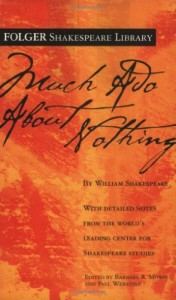It’s no wonder I enjoyed Shakespeare’s Much Ado About Nothing. Aside from the language, it could be a contemporary romance. Granted it’s a play and therefore shorter than most novels, which means there’s not as much lead up. You can fall in love fairly quickly in a play. There are two couples. The first, Benedick and Beatrice, are familiar characters. Both have sharp tongues, love to play with words, and have announced their scorn for marriage and, of course, for each other. Just like in any story, though, they belong together and their friends and family trick them into revealing their love for each other. The second couple, Claudio and Hero, are sweet, young and obviously in love. Claudio is tricked into rejecting Hero, thinking her unfaithful, but of course it works out in the end, thanks to Dogberry, a constable who is constantly using the wrong words which is rather amusing. He discovers that the villain is Don John. In the end, Don John is captured and everyone joins in a dance celebrating the marriages.
In The Tempest, there were a lot of flowing monologues. Much Ado About Nothing is different, less poetry, more prose. It’s the dialogue that carries the play; it’s quicker, witty, full of double entendre. It’s just overall a funner play, at least for me.
Messenger: I see, lady, the gentleman is not in your books.
Beatrice: No. An he were, I would burn my study.
(1.1.76-78)
If it prove so, then loving goes by haps;
Some Cupid kills with arrows, some with traps.
(3.1.111-112) Hero
Beatrice: Will you go hear this news, signior?
Benedick: I will live in thy heart, die in thy lap, and be buried in thy eyes—and, moreover, I will go with thee to thy uncle’s.
(5.3.100-103)
Claudio: Now you talk of a sheet of paper, I remember a pretty jest your daughter told us of.
Leonato: O, when she had writ it and was reading it over, she found “Benedick” and “Beatrice” between the sheet?
(2.3.142-146)
I like Beatrice, she’s got spunk. And while they may insult her, it’s done in a joking manner. She’s allowed to be who she is. Of course, being the time period, for the play to have a happy ending, she has to get married, but that’s okay. It fits. They remind me of Elizabeth and Darcy, and any number of other fictional couples through the years. They don’t see how perfect they are for each other at first, but we the readers know they’ll be together in the end.
I’ll grant you there is a lot of worry about being cheated on. The men in the play seem to be rather suspicious that women are bound to cheat on them. But, apparently love’s worth the risk.
I read an annotated version, this one from the Folger Shakespeare Library published by Simon and Schuster. The annotations and on the pages facing the text, so if you open it to a random part, the annotations will be on the left page, sometimes with a silly little illustration, and the text will be on the right. I personally prefer the ones annotated by Burton Raffel, published by Yale University Press, like The Tempest I just read and A Midsummer Night’s Dream which I’ve started.. The annotations are on the bottom of the page, which I find less distracting, also I think the introductions are better, giving a fuller picture of the play, the characters, and also talking about the theater in Shakespeare’s time.
Much Ado About Nothing is a light readable romance. Technically it’s a comedy because of the happy ending, but I’ve never quite understood that comedy or tragedy way of looking at things, so I’m calling it a romance. And an enjoyable one at that.
5 out of 5 stars
Category: Classics- Play
Amazon | IndieBound | Read on-line
First published 1598
198 pages
Book source: Library
Shakespeare Reading Month is hosted by Allie at A Literary Odyssey.

I haven’t read Shakesspeare since my college days, but I rememberenjoying it. Kudos to Carol for picking up a classic!
If all goes to plan I will be reading this play in April. I am glad you enjoyed it!
I do think…yes that I will rather just watch the movies that are being made 😉
Not a bad plan.
I can’t remember when I last read anything by Shakespeare but I’m guessing it was in school. Glad you enjoyed it.
I’ve seen this a couple of times on stage. Great fun!
I would love to see it on stage. I bet it’s great live.
I’m so impressed that you’re reading Shakespeare! I should probably see if I could understand one at my advanced age.
Advanced age my foot. Anyway, I have to have the annotated versions or I’d be lost.
I’ve never read the play but I love the movie with Kenneth Branagh, Michael Keaton, Denzel Washington, Keanu Reeves, and Emma Thompson.
I’m going to see if our library has a copy of it.
Oooo…I have a copy of this one. I’ll have to pull it off of the shelf!
This was a good one. I’ve never read an annotated version but you’ve made me curious. I might have to see what the library has. Might be a fun way for me to revisit some of his plays.